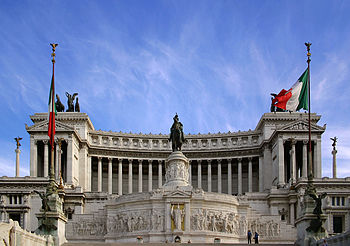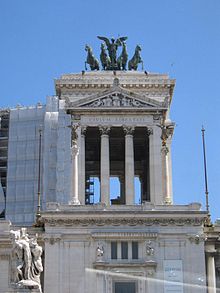- Altare della Patria
-
Coordinates: 41°53′41″N 12°28′59″E / 41.894599°N 12.483092°E
The Monumento Nazionale a Vittorio Emanuele II (National Monument to Victor Emmanuel II) or Altare della Patria (Altar of the Motherland) or "Il Vittoriano" is a monument built to honour Victor Emmanuel, the first king of a unified Italy, located in Rome, Italy. It occupies a site between the Piazza Venezia and the Capitoline Hill. The monument was designed by Giuseppe Sacconi in 1885; sculpture for it was parceled out to established sculptors all over Italy, such as Angelo Zanelli.[1] It was inaugurated in 1911 and completed in 1935.[2]
The monument is built of white marble from Botticino, Brescia, and features stairways, Corinthian columns, fountains, an equestrian sculpture of Victor Emmanuel and two statues of the goddess Victoria riding on quadrigas. The structure is 135 m (443 ft) wide and 70 m (230 ft) high. If the quadrigae and winged victories are included, the height is to 81 m (266 ft).[2]
The base of the structure houses the museum of Italian Reunification.[2][3] In 2007, a panoramic elevator was added to the structure, allowing visitors to ride up to the roof for 360 degree views of Rome.[4]
Contents
Unknown soldier
The monument holds the Tomb of the Unknown Soldier with an eternal flame, built under the statue of Italy after World War I following an idea of General Giulio Douhet. The body of the unknown soldier was chosen on October 26, 1921 from among 11 unknown remains by Maria Bergamas, a woman from Gradisca d'Isonzo whose only child was killed during World War I. Her son's body was never recovered. The selected unknown was transferred from Aquileia, where the ceremony with Bergamas had taken place to Rome and buried in a state funeral on November 4, 1921.
Controversy
The monument was controversial since its construction destroyed a large area of the Capitoline Hill with a Medieval neighbourhood for its sake. The monument itself is often regarded as pompous and too large.[3][5][6]
It has been described as being "chopped with terrible brutality into the immensely complicated fabric of the hill."[7]
It is clearly visible to most of the city of Rome despite being boxy in general shape and lacking a dome or a tower.[2] The monument is also glaringly white, making it highly conspicuous amidst the generally brownish buildings surrounding it, and its stacked, crowded nature has lent it several nicknames. Foreign people sometimes refer to the structure by a variety of nickname, such as "the wedding cake" and Romans as "the typewriter".[8] Despite all this criticism, the monument still attracts a large number of visitors. Italian President Carlo Azeglio Ciampi fostered the opening of the Vittoriano as a public forum and viewpoint over the City core. This new accessibility allowed visitors to become familiar with the landmark, enabling it to grow in popular, if not critical, reputation.
Media
It was featured in the 2003 movie The Core where it collapses due to being struck by huge bolts of lightning. It was also featured in the 1987 movie The Belly of an Architect by Peter Greenaway. It was also featured in the movie Under the Tuscan Sun starring Diane Lane.
References
- ^ Sandra Berresford, Italian Memorial Sculpture, 1820-1940: A Legacy of Love56.
- ^ a b c d Vidotto, Vittorio (PDF). The Invention of Two Capital Cities. Archaeology and Public Spaces in Athens and Rome. European Association for Urban History. Archived from the original on 2007-02-21. http://web.archive.org/web/20070221064625/http://www.historia.su.se/urbanhistory/eauh/papers/r2_vidotto.pdf. Retrieved 2007-02-26.
- ^ a b d'Aquino, Niccolò (February 2001). "Capitals: Rome". Europe (403): 36–38.
- ^ http://roma.repubblica.it/dettaglio/Vittoriano-su-con-lascensore-da-oggi-le-terrazze-con-vista/1313015 Vittoriano, su con l'ascensore da oggi le terrazze con vista
- ^ Atkinson, David; Cosgrove, Denis (March 1998). "Urban Rhetoric and Embodied Identities: City, Nation, and Empire at the Vittorio Emanuele II Monument in Rome, 1870-1945". Annals of the Association of American Geographers 88 (1): 28–49. doi:10.1111/1467-8306.00083.
- ^ Peter Davey (October 1996). "Outrage". The Architectural Review 200 (1196): 25.
- ^ Peter Davey, "Outrage - the Vittorio Emanuele II monument in Rome", The Architectural Review (October 1996).
- ^ Steeves, Rick (2009-02-04). "Here's what's new in Italy for 2009". The Seattle Times (Tribune Media Services). http://seattletimes.nwsource.com/html/ricksteveseurope/2008707252_websteves04.html?cmpid=2628. Retrieved 2009-02-05.
External links
Categories:- Visitor attractions in Rome
- Buildings and structures in Rome
- Monuments and memorials in Italy
- Altars
- National symbols of Italy
- Victor Emmanuel II of Italy
Wikimedia Foundation. 2010.


